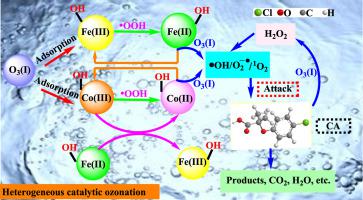Journal of Hazardous Materials ( IF 12.2 ) Pub Date : 2020-11-18 , DOI: 10.1016/j.jhazmat.2020.124604 Chun Cai , Xiaodi Duan , Xianjun Xie , Shuping Kang , Chanjuan Liao , Jiaming Dong , Yangfan Liu , Shaofeng Xiang , Dionysios D. Dionysiou

|
CoFe2O4 (Cobalt ferrite, CF) nanoparticles were prepared, well characterized and applied as efficient solid catalyst in catalytic ozonation, named CF/O3 process, for the removal of emerging organic contaminants (EOCs). The degradation and mineralization of clofibric acid (CA) in CF/O3 process were dramatically enhanced in comparison with those under the O3 system. Surface hydroxyl groups (HGs) were considered as an important factor for ozone decomposition and the reactive oxygen species (ROS) on the catalyst surface were mainly responsible for CA elimination. The contribution and formation of ROS, including hydroxyl radicals (•OH), especially superoxide radicals (O2•−), singlet oxygen (1O2), and hydrogen peroxide (H2O2) were evaluated, and a rational mechanism was elucidated accordingly. Probable degradation pathway of CA was proposed according to the organic intermediates identified. The acute toxicity of the treated solution increased during the first 15 min and then declined rapidly and nearly disappeared as the reaction proceeded. In addition, acceptable catalytic performance of CF/O3 can be obtained for the treatment of other EOCs and the destruction of natural surface water spiked with CA. This work presents an efficient and promising catalytic ozonation technique for the elimination of EOCs in complex water matrices.
中文翻译:

使用CoFe 2 O 4催化剂在水中进行非均相催化臭氧化技术有效降解氯纤维酸
制备了CoFe 2 O 4(钴铁氧体,CF)纳米颗粒,对其进行了很好的表征,并将其用作催化臭氧化中的高效固体催化剂,称为CF / O 3工艺,用于去除新兴的有机污染物(EOC)。与O 3系统相比,CF / O 3工艺中的氯纤维酸(CA)的降解和矿化作用显着增强。表面羟基(HGs)被认为是臭氧分解的重要因素,催化剂表面的活性氧(ROS)主要是消除CA的原因。ROS的贡献和形成,包括羟基自由基(• OH),尤其是超氧自由基(O 2评估了?-,单线态氧(1 O 2)和过氧化氢(H 2 O 2),并据此阐明了合理的机理。根据确定的有机中间体,提出了CA可能的降解途径。处理后的溶液的急性毒性在开始的15分钟内增加,然后迅速下降,并随着反应的进行而几乎消失。此外,对于其他EOC的处理以及掺入CA的天然地表水的破坏,可以获得可接受的CF / O 3催化性能。这项工作提出了一种有效而有希望的催化臭氧化技术,用于消除复杂水基质中的EOC。









































 京公网安备 11010802027423号
京公网安备 11010802027423号